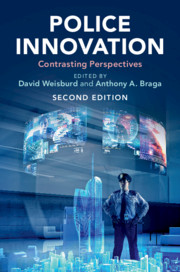Book contents
- Police Innovation
- Police Innovation
- Copyright page
- Contents
- Figures
- Tables
- Notes on Contributors
- Introduction
- Part I Community Policing
- Part II Procedural Justice Policing
- Part III Broken Windows Policing
- Part IV Problem–Oriented Policing
- Part V Pulling Levers (Focused Deterrence) Policing
- Part VI Third–Party Policing
- Part VII Hot Spots Policing
- Part VIII Predictive Policing
- Part IX CompStat
- Part X Evidence-Based/ Risk-Focused Policing
- 19 Advocate
- 20 Critic
- Part XI Technology Policing
- Index
- References
20 - Critic
Which Evidence? What Knowledge? Broadening Inform-ation about the Police and Their Interventions
from Part X - Evidence-Based/ Risk-Focused Policing
Published online by Cambridge University Press: 09 August 2019
- Police Innovation
- Police Innovation
- Copyright page
- Contents
- Figures
- Tables
- Notes on Contributors
- Introduction
- Part I Community Policing
- Part II Procedural Justice Policing
- Part III Broken Windows Policing
- Part IV Problem–Oriented Policing
- Part V Pulling Levers (Focused Deterrence) Policing
- Part VI Third–Party Policing
- Part VII Hot Spots Policing
- Part VIII Predictive Policing
- Part IX CompStat
- Part X Evidence-Based/ Risk-Focused Policing
- 19 Advocate
- 20 Critic
- Part XI Technology Policing
- Index
- References
Summary
Observations while attending several crime analysis meetings of a major city police department provide insight into questions of sources and importance of knowledge in policing. This observable knowledge is used by the police as they grapple with the ongoing complexities of public safety, in this case in an urban city.
At each meeting, two forms of knowledge framed discussions of crime and disorder problems. Framing as a sociological and communications theory relies on ideas associated with understanding how attitudes and behavior are shaped by the information or form of knowledge presented (Goffman, 1986; Scheufele & Iyengar, 2014).
- Type
- Chapter
- Information
- Police InnovationContrasting Perspectives, pp. 457 - 482Publisher: Cambridge University PressPrint publication year: 2019
References
- 5
- Cited by



